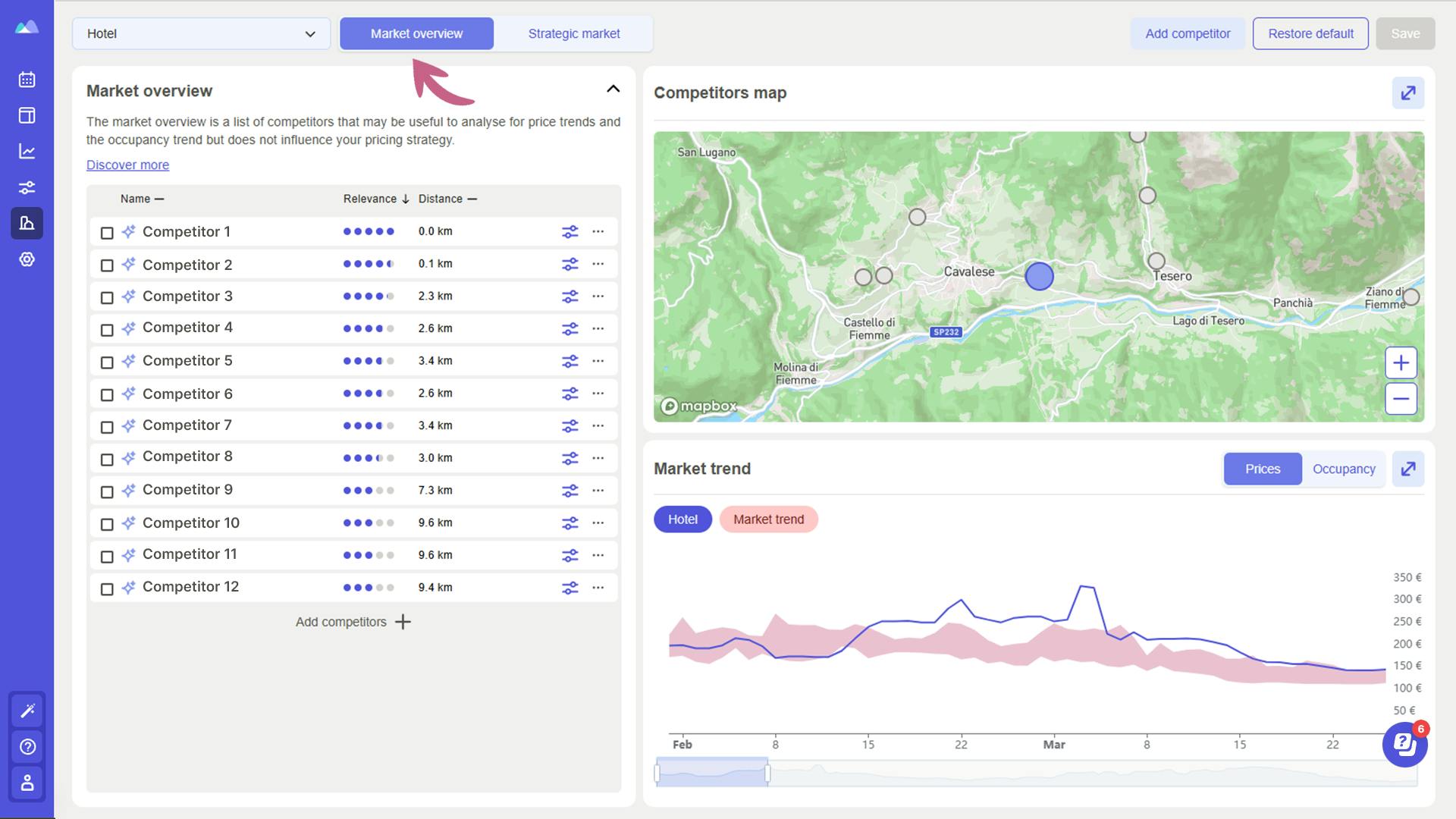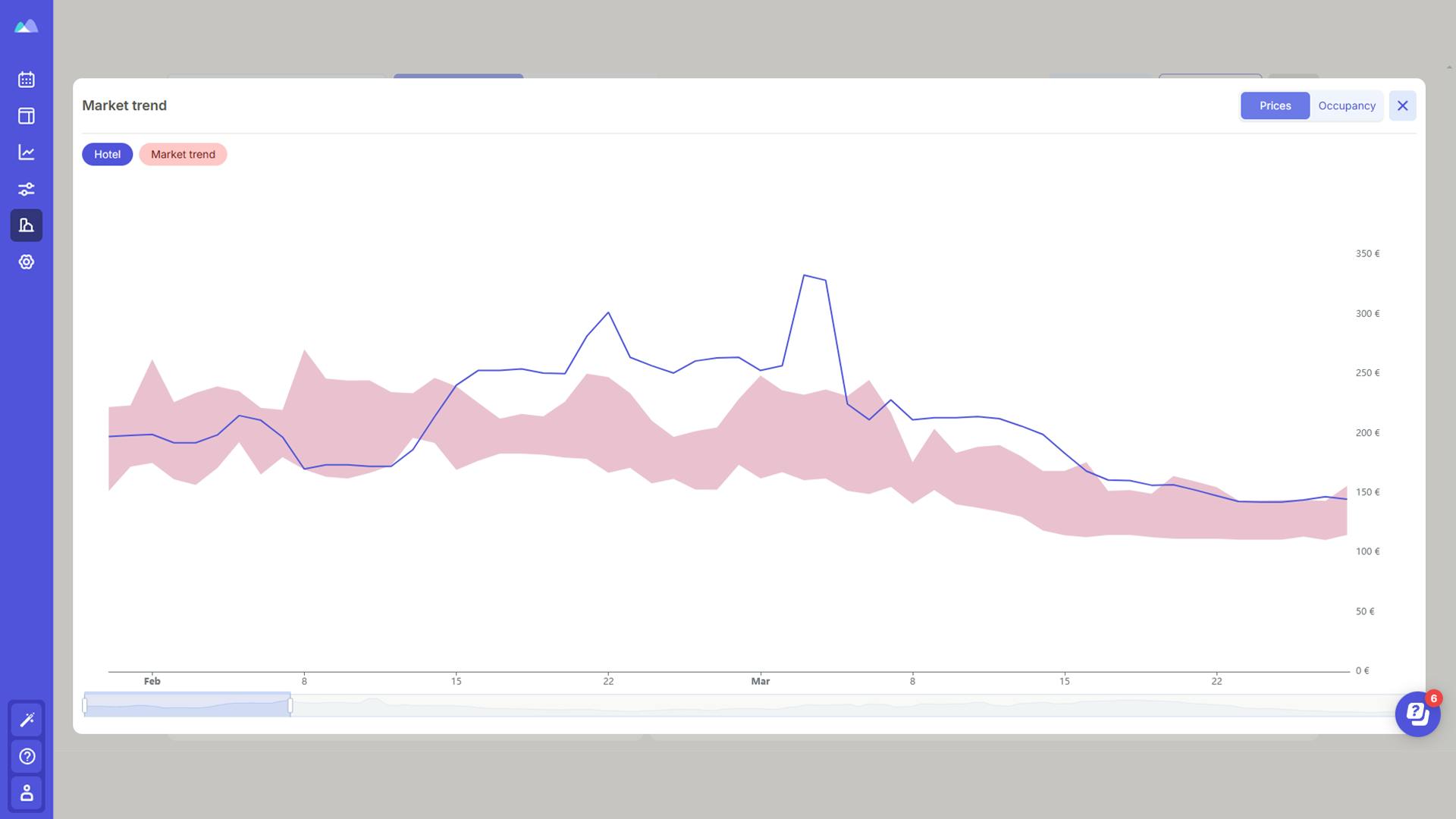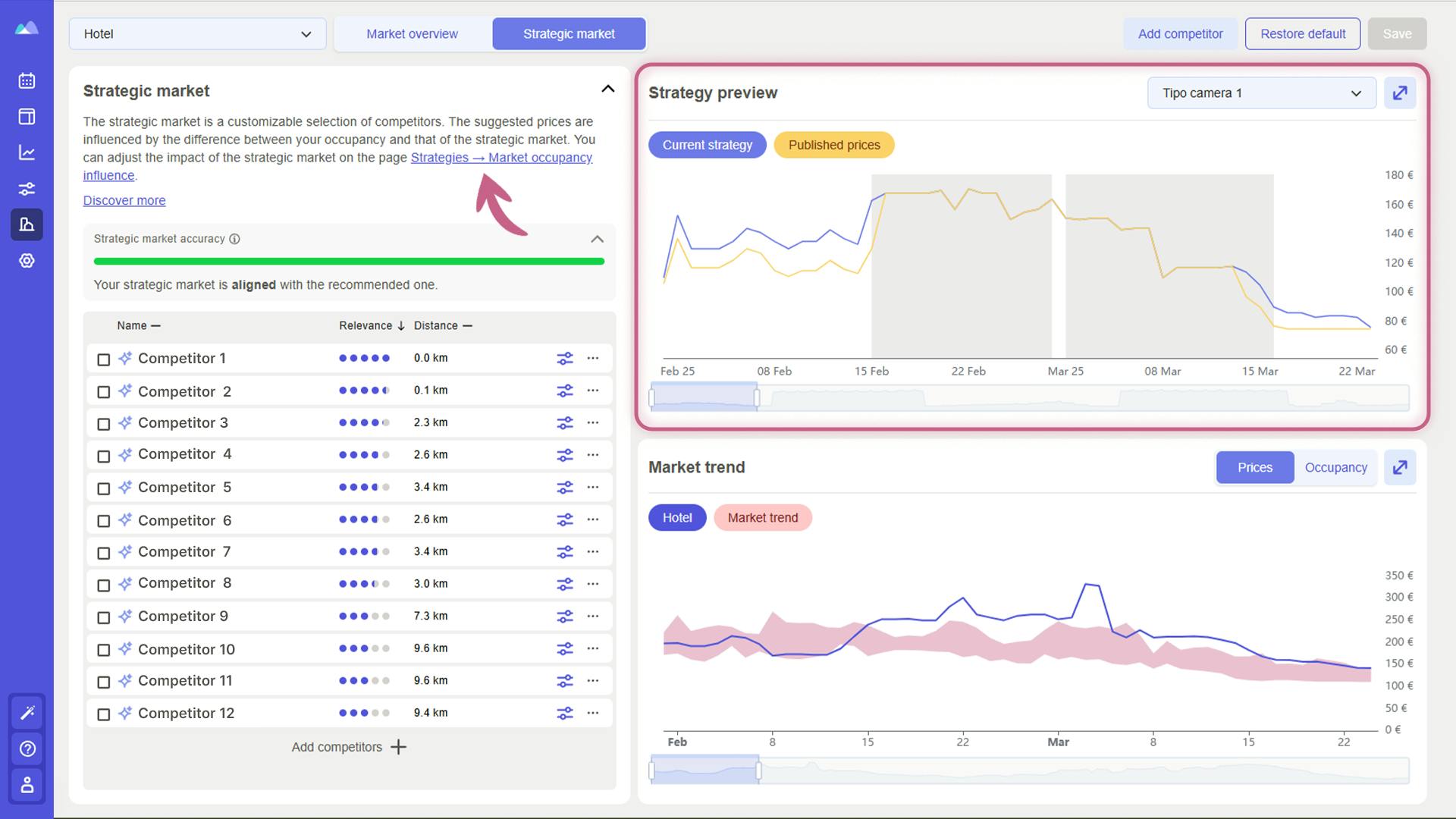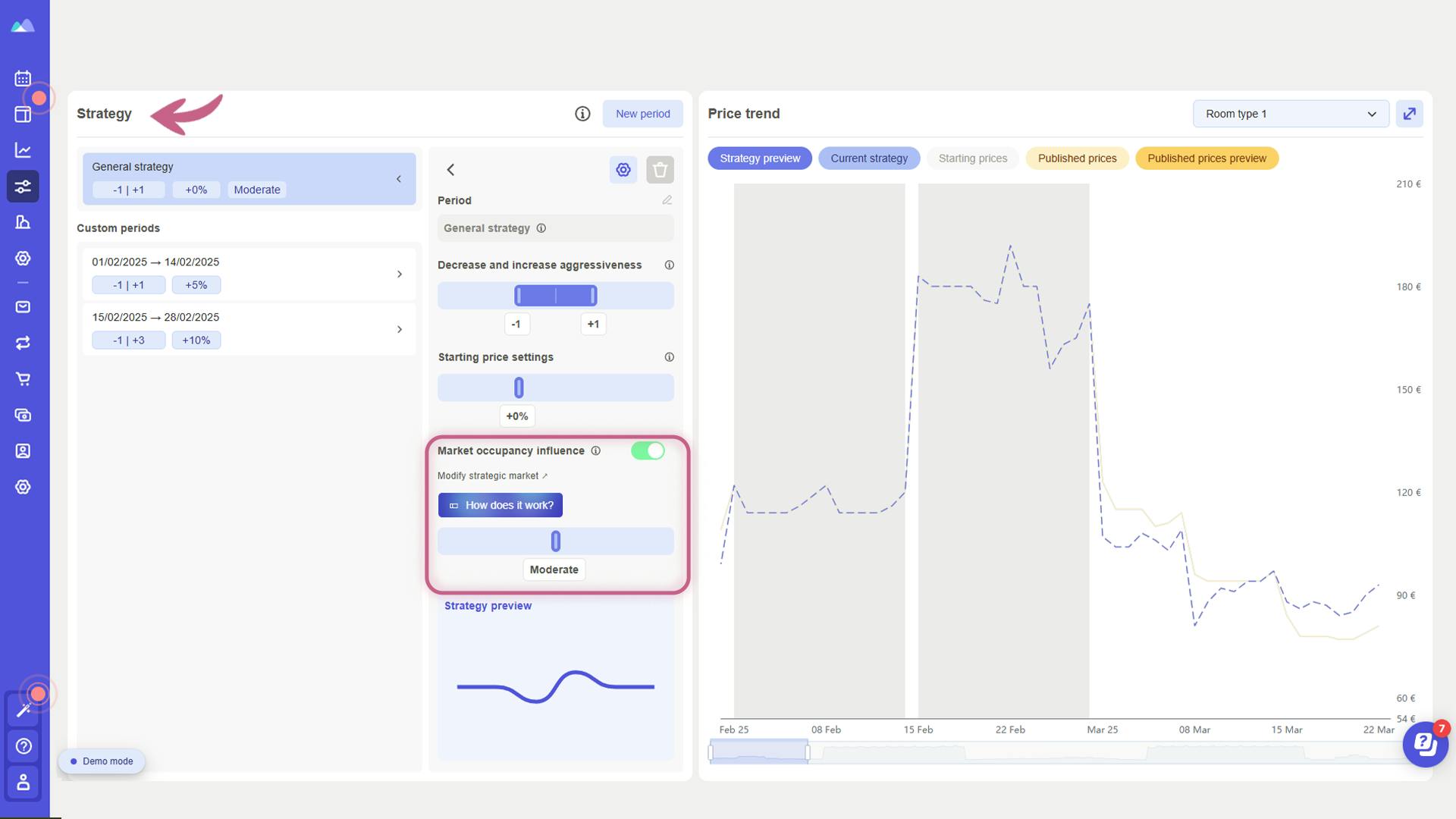Monitoring hotel competitors: How to analyze prices and occupancy
Find out what risks to avoid and how to create a truly competitive pricing strategy.

You’ve just set your hotel’s rates and want to know if they’re truly competitive. What do you do? Your first instinct is probably to check your competitors’ prices for reference.
That’s a smart move—pricing is a key factor in attracting guests and maximizing revenue, and analyzing the competition is essential. But are you sure you’re doing it the right way?
There’s a fine line between leveraging this data to refine your strategy and falling into the trap of simply copying competitor prices without careful consideration.
If you want to avoid costly mistakes, keep reading! In this article, you’ll learn the advantages and pitfalls of competitor monitoring—and how to turn it into a truly strategic asset for your hotel.
3 reasons why competitor monitoring is essential
Tracking competitor pricing allows you to make informed decisions and fine-tune your pricing strategy effectively. Here’s why it matters:
1. Understanding market trends
Monitoring competitors helps you identify seasonal trends and understand how demand fluctuates over time.
Example: You run a hotel in a tourist destination where an annual event takes place—one you’ve never paid much attention to. By tracking your competitors, you notice that some start gradually raising their prices months in advance, while others keep them steady until the last minute. By analyzing these trends alongside your booking history, you realize that demand begins to rise well ahead of the event. Armed with this knowledge, you can dynamically adjust your rates in advance and avoid selling rooms too early at lower-than-optimal prices.
2. Staying competitive
Pricing too high can drive guests away, while pricing too low can lower the perceived value of your hotel and shrink your profit margins. Monitoring competitors helps you strike the right balance between competitiveness and profitability.
Example: You manage a 4-star hotel and discover that competitors are offering packages with breakfast included at a similar rate to your base price (which does not include breakfast).
Instead of lowering your rates, you could consider including breakfast at no or minimal extra cost—if operational expenses allow.
This way, your offering gains a higher perceived value while remaining competitive, without significantly impacting margins. Adding an essential service like breakfast can be the deciding factor for potential guests.
3. Seizing opportunities
Keeping an eye on price fluctuations in your market helps you spot the perfect moment to raise or lower rates—so you don’t leave money on the table.
Example: You run a B&B in a cultural city where a new low-cost airline route has just been announced. By monitoring competitor pricing, you notice that many have already raised their rates for upcoming weekends. If you miss this trend, you might keep selling rooms at standard rates, missing out on a revenue boost during peak demand. Staying alert to market shifts allows you to adjust prices proactively and maximize revenue.
3 reasons why competitor monitoring can be risky
While tracking your competitors can offer valuable insights, there are also potential pitfalls that can undermine your revenue strategy. Here are three key risks to watch out for:
1. High time investment
Manually checking competitor prices on OTAs or other sales channels can quickly become a full-time job. You need to carefully select which competitors to monitor and conduct near-daily comparisons to keep track of your market positioning and capture every price fluctuation.
Because of this, many hotels either give up on competitor monitoring altogether or do it only occasionally—risking missed revenue opportunities.
2. Ignoring your own costs and brand identity
Simply copying competitor prices without considering your own costs and the value you offer can be a costly mistake. Pricing too low can erode margins, threaten long-term sustainability, and make it harder to maintain service quality.
At the same time, blindly following competitor strategies can dilute your brand identity and make your property indistinguishable from the rest. Without a clear pricing strategy, you risk getting caught in a race to the bottom—harming both profitability and perceived value.
Want to learn how to choose the right competitors to benchmark against? Check out our guide on selecting a competitive set for hotels.
3. Focusing only on prices and not occupancy
Looking solely at competitor prices without factoring in their occupancy rates can lead to misleading conclusions.
For example: A hotel might drop its prices, not because of market conditions, but simply because it still has a high number of unsold rooms. Conversely, a competitor with high prices might already have a strong occupancy rate and is simply optimizing the last remaining rooms.
Gathering this information manually is complex—if not impossible—which is why using a dedicated tool can make all the difference.
How to use Smartpricing to monitor competitors
The Market Analysis page in Smartpricing allows you to track competitor data much more quickly and accurately.
In the Market Overview section, you’ll see a list of relevant competitors, ranked by the algorithm based on key factors such as location, property type, online reviews, available amenities, published rates, and seasonality. You can also manually add competitors at any time.

Practical example:
You’re struggling to sell rooms in late February—bookings aren’t coming in, and the arrival date is getting closer.
In the Market Trends section (bottom right), you can view a pricing graph that compares your rates with overall market trends, as shown in the screenshot below:

How can you use this information?
Let’s continue with our example by looking at the screenshot: In the second half of February, your rates are higher than the market trend. Based on this information, you can decide what to do—lower your price to align with the market or do nothing.
This is where it becomes essential to cross-analyze competitor data with your operating costs: For example, you may be unable to drop below €200 per night in February because your costs would exceed your revenue.
In this case, you can still act strategically: Before lowering your rate for this period, simply set a minimum price threshold that the algorithm will never go below. This way, even if the algorithm lowers prices to increase booking probability, you can be sure it will never drop below your defined limit.
Would you like to see the suggested list of your potential competitors right away? You can do so with Smartpricing Free—the free tool that helps you identify your competitive set and immediately compare your prices with those of your competitors. To use it, all you need to do is create a free account!
However, keep in mind: Smartpricing Free does not connect to your PMS, does not factor in your internal hotel data, and does not provide insights into market occupancy. It’s a great starting tool, but all the features described in this article are exclusively available in the full Smartpricing subscription.
How to use Smartpricing to optimize your pricing strategy based on market occupancy
As we’ve seen, one of the risks is only monitoring prices while ignoring market occupancy, which could lead to overlooking critical issues or valuable opportunities.
For example: Your pricing analysis indicates that your rates are aligned with the market. However, when checking occupancy, you notice that your competitors have an average occupancy of 80%, while yours is stuck at just 10%. This is a major red flag—your destination is attracting bookings, but guests are choosing every other property except yours.
To boost your OTA ranking, you may need to lower your prices below the market average. But be careful! At the same time, you need to continue tracking occupancy:
If your occupancy rapidly increases, while the market remains flat, it’s a clear sign that your listing is performing better than your competitors. In this case, you can raise your rates again to maximize your margins.
The problem? Manually estimating market occupancy is extremely difficult—if not impossible. That’s why the “Market Analysis” page in Smartpricing includes a dedicated “Strategic Market” section.
Here, you can either accept the list of competitors suggested by the algorithm or customize it according to your preferences. From that moment on, the Smartpricing algorithm will automatically increase or decrease the suggested price based on the difference between your occupancy and that of your strategic market.

Naturally, you can determine the extent to which the algorithm should be influenced by market occupancy fluctuations: Simply go to the "Strategy" page and use the "Market Occupancy Influence" feature to set the level of intensity with which the algorithm adjusts the suggested price based on market occupancy changes.

The analysis and strategy adjustments we’ve discussed in this article take just a few minutes of your day. Once done, you’ll be free to focus on other strategic tasks at your property – while Smartpricing continuously monitors the market and optimizes your rates automatically according to your set strategy.
Likewise, you’ll no longer have to manually update every price change in your PMS or Channel manager – Smartpricing will sync everything for you.
Want to see how Smartpricing works and how much extra revenue it could help you generate Request a free, personalized demo today!
